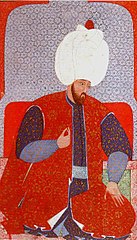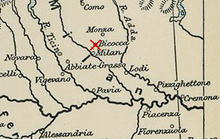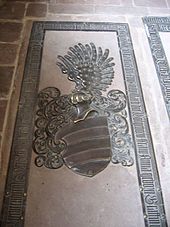1522
Portal History | Portal Biographies | Current Events | Annual Calendar | Article of the day
◄ |
15th Century |
16th Century
| 17th century
| ►
◄ |
1490s |
1500s |
1510s |
1520s
| 1530s
| 1540s
| 1550s
| ►
◄◄ |
◄ |
1518 |
1519 |
1520 |
1521|
1522
| 1523
| 1524
| 1525
| 1526
| ►
| ►►
Heads of State · Obituary · Year of Literature · Year of Music
| 1522 | |
|---|---|
|
Suleiman I begins the new siege of Rhodes . |
Adrian of Utrecht is known under the name Hadrian VI. pope. |
| Juan Sebastián de Elcano completes the first circumnavigation begun by Ferdinand Magellan . | |
| 1522 in other calendars | |
| Armenian calendar | 970/971 (July turn of the year) |
| Ethiopian calendar | 1514/15 |
| Aztec calendar | 3rd house – Jei Calli (until the end of January/beginning of February: 2nd flint – Ome Tecpatl ) |
| Buddhist calendar | 2065/66 (Southern Buddhism); 2064/65 (alternative calculation according to Buddha's parinirvana ) |
| Chinese calendar | 70th (71st) cycle
Year of the Water Horse壬午 ( at the beginning of the year Metal Snake 辛巳) |
| Chula Sakarat (Siam, Myanmar) / Dai calendar (Vietnam) | 884/885 (New Year April) |
| Dangun era (Korea) | 3855/56 (October 2nd/3rd) |
| Iranian calendar | 900/901 |
| Islamic calendar | 928/929 (change of the year November 19th/20th) |
| Jewish calendar | 5282/83 (21/22 September) |
| Coptic calendar | 1238/39 |
| Malayalam calendar | 697/698 |
| Seleucid era | Babylon: 1832/33 (April turn of the year)
Syria: 1833/34 (October turn of the year) |
| Vikram Sambat (Nepalese calendar) | 1578/79 (April turn of the year) |
events
politics and world affairs
Siege of Rhodes
The Ottoman Empire , under the command of Çoban Mustafa Pasha, begins the Siege of Rhodes on 26 June . The island is defended by the Knights Hospitaller , who have owned the island since 1306. The Ottoman fleet consists of almost 300 ships, the invading army is possibly up to 160,000 strong and includes an elite force of about 10,000 Janissaries. The Ottoman warships begin the siege by blockading the port of Rhodes .
After the siege of 1480 and an earthquake in 1481, the Hospitallers had the fortifications of the city of Rhodes greatly expanded and extended. The city is protected by a double, sometimes even triple ring of solid walls and several particularly large circular towers . The harbor entrance is blocked by a large chain, behind which the Johanniter fleet is stationed at a safe distance. The Hospitallers divide the walls of the city into several sections, which the respective “tongues” of the order are responsible for defending. Overall, the garrison of the city with its 180 knights and their entourage, mercenaries and locals comprised a few thousand men. The Order's forces are commanded by Grand Master Philippe de Villiers de l'Isle-Adam .
On June 28, Sultan Süleyman I arrives at Rhodes to personally take command of his troops. However, the heavy cannonade that followed only slowly damaged the city's massive walls. For weeks, several assaults are repelled by the besieged, with the besiegers taking heavy casualties.
On September 24th, by far the largest assault up to that point, the Ottoman troops almost succeeded in penetrating the city. However, the Hospitallers repulsed the attack, killing several thousand Anatolian soldiers and Janissaries. In the weeks that followed, the Ottoman army continued to shell and carry out more assaults without success.
On 27 October, the Hospitallers discover that the Order's Grand Chancellor , André do Amaral , has assigned one of his servants to secretly fire embassies into the Ottoman camp. Both men are therefore accused of high treason and executed. A ceasefire is agreed for December 11-13 to allow negotiations. However, the city's surrender, demanded by the Ottomans, is rejected, so fighting flares up again.
On December 17, the Ottomans succeed in conquering the "Tower of Spain", which makes the defense of the city practically impossible. The Johanniter thereupon capitulated on December 22 under the condition that they be granted free withdrawal. On January 1, 1523, they left the island, along with several thousand locals.
The conquest of Rhodes is an important step for the Ottoman Empire on its way to complete domination of the eastern Mediterranean. After their expulsion from Rhodes, the Johanniter first settled on Crete.
Knight's War in Southern Germany
In August, a gathering of 600 Upper Rhine and Franconian knights in Landau , who were struggling with economic problems and social decline at the end of the Middle Ages , elected the famous knight and mercenary leader Franz von Sickingen as their federal governor. Although this "brotherly association" was influenced by the early Reformation movement, it stands in the tradition of older societies of knights. First of all, she relies on peaceful protest and the effect of her demonstration of power.
Fueled by Ulrich von Hutten 's aggressive polemics , who called for a war of priests against princes and clergy, von Sickingen ultimately took up arms and began the Knights ' War . However, he obviously overestimated the solidarity of the knightly nobility; Although he attracts numerous knights through his daring demeanor and the territorial power base on which he can rely, an empire-wide uprising does not materialize. Most noble families wait and see, making their later participation dependent on the previous success of the enterprise.
A princely coalition quickly formed against Sickingen's uprising, consisting of the Archbishop of Trier and Elector Richard von Greiffenklau zu Vollrads , Count Palatine Ludwig V and Landgrave Philipp I of Hesse . In September, the siege of Trier by the insurgents had to be broken off, and Sickingen had to withdraw to its Nanstein Castle near Landstuhl .
Other events in the kingdom
- August: At the Wiener Neustadt blood court, leading members of the Estates opposition, the mayor of Vienna Martin Siebenbürger , the nobles Michael von Eytzing and Hans von Puchheim, as well as the councilors Hans Rinner, Stefan Schlagindweit, Friedrich Pietsch, Martin Flaschner and Hans Schwarz, are sentenced after an indictment executed by Archduke Ferdinand I by Markus Beck . Vienna and Wiener Neustadt are now under direct imperial control. The property of the executed is confiscated.
- Peine Castle is again besieged in vain during the Hildesheim collegiate feud . The Bishopric of Hildesheim is banned by Emperor Charles V.
Western and Southern Europe
- February: The Comuneros uprising in Spain is finally crushed.
- April 27: In the Battle of Bicocca , the troops of Emperor Charles V prevail over the army sent by the French King Francis I in northern Italy. Arquebuses and artillery of the smaller Spanish-Habsburg forces are crucial in the battle of arms. After the battle, the Duchy of Milan came under the imperial sphere of influence.
- June 19: In the Treaty of Windsor , the English King Henry VIII and Emperor Charles V agree on a joint plan of attack against France . As a result of the treaty, the English attacked Brittany and Picardy from Calais in July . King Francis I of France is unable to raise large mercenary armies to resist due to lack of funds, and the English army pillages and pillages in these regions.
Eastern Europe
- September 14: After a short period of negotiations, an armistice treaty is signed between the Grand Duchy of Lithuania and the Grand Duchy of Moscow in Moscow (initially for five years, later extended to 1533). Smolensk is specifically mentioned in the text of the treaty as a current possession of Moscow. (cf. Russo-Lithuanian Wars )
Elcano's circumnavigation

- February 11: The Victoria , one of the last two remaining ships of Ferdinand Magellan 's circumnavigation , sets sail from Timor under the command of Juan Sebastián Elcano and sets out to cross the Indian Ocean . The journey home is marked by difficult weather conditions.
- March 18: The expedition of Juan Sebastián Elcano discovers Amsterdam Island .
- April 4: The second ship Trinidad , which stayed behind on the Molucca island of Tidore last year for necessary repairs , tries to make the voyage home across the Pacific, but a 12-day storm forces the crew to return.
- May 19: The Cape of Good Hope is circumnavigated.
- July 9: The Victoria reaches the Cape Verde Islands . The Portuguese attempt to prevent the ship from returning home and capture 13 Spanish crew members. Because of the ship's poor condition, Elcano decides not to rescue the ship and sails home.
- September 7th: Juan Sebastián Elcano 's expedition completes the first circumnavigation of the world with the arrival in the home port of Sanlúcar de Barrameda . Of the original 237 crew members, only 18 are returning. Despite careful bookkeeping, the team is also missing a day in the calendar. It was only much later that the need for a date line was recognized.
- Late October/early November: Last 18 Trinidad survivors surrender to Portuguese on Ternate , neighboring island of Tidore. You will be thrown in prison for several years.
business
Elector Friedrich the Wise of Saxony has the Schautaler of Friedrich the Wise minted . This shows the portrait of the Saxon elector with a beret on the front and a floral cross on the back with the first letters of the words of his motto in the corners. Hans Krafft the Elder cut the embossing stamp on the front in Nuremberg after a painting by Lucas Cranach the Elder .
science and technology
On December 21, the carrack Santa Anna was launched in Nice, one of the largest and most modern ships of its time. Her distinctive feature is her hull , partially studded with lead plates, which some authors consider to be an early form of ship armor , while others see reducing water permeability as its primary purpose. The Santa Anna 's armament is designed for 500 soldiers. A smithy is housed in the ship, in which several weapon smiths can also pursue their work on the high seas. The ship even has its own windmill and ovens on board, which are used to provide the crew with fresh bread. In addition, the Santa Anna has a garden with plants hung in flower boxes along the stern gallery.
Culture
architecture
Portuguese seafarers built the Capela de Nossa Senhora do Baluarte on the Ilha de Moçambique , the oldest colonial structure on the coast of the Indian Ocean and the only surviving structure in the Manueline style in modern-day Mozambique .
literature
The Story of the Three Kingdoms , a novel by Chinese author Luo Guanzhong about the turbulent period of the Three Kingdoms , is published in its first draft with 240 chapters. The work is ranked among the four classic novels of Chinese literature and is one of the most popular Chinese novels . There is no central plot, but the novel forms a large historical painting consisting of individual episodes that are self-contained and contain an immense variety of characters.
society
The Friedrichgymnasium in Altenburg is founded as a municipal Latin school .
religion
- 9 January: The German Adrian von Utrecht is elected pope at the 1521-1522 conclave , succeeding Leo X , who had died the previous year . He takes the name Hadrian VI. on.
- March 9: The breaking of the rule of fasting with a sausage meal on the first Sunday of the month of fasting in the house of the printer Christoph Froschauer in Zurich is considered the "primal date" for the Reformed Church . Ulrich Zwingli defends the action with the argument that fasting is not a divine law. As early as Ash Wednesday , March 5th, a violation of the fasting requirement was recorded as an administrative offense in Zurich.
- March 9–16: Martin Luther delivers eight invocavit sermons .
- September: Luther publishes the September Testament , a translation of the New Testament , at the Leipzig Book Fair .
Born
date of birth saved
- January 23: Georg Kleefeld , Mayor of Danzig († 1576)
- February 2: Lodovico Ferrari , Italian mathematician (died 1565)
- February 22: Lampert Distelmeyer , electoral chancellor of the Mark Brandenburg († 1588)
- March 2: Heinrich Salmuth , German Lutheran theologian and reformer (died 1576)
- March 28: Albrecht Alcibiades , Margrave of Brandenburg-Kulmbach († 1557)
- April 19: Joachim von Beust , German jurist († 1597)
- April 23: Caterina de' Ricci , Florentine Dominican and mystic, Catholic saint (d. 1590)
- May 22: John Jewel , Bishop of Salisbury (died 1571)
- July 5: Margaret of Parma , illegitimate daughter of Emperor Charles V, Duchess of Florence, Duchess of Parma and Piacenza, governor of the Habsburg Netherlands († 1586)
- July 13: Sophia Jagiellonica , Polish princess, Duchess of Brunswick-Wolfenbüttel († 1575)
- July 31: Charles II de Croÿ , Duke of Aarschot and Prince of Chimay († 1551)
- September 11: Ulisse Aldrovandi , Italian physician and naturalist (died 1605)
- October 14: Lucas Maius , German evangelical theologian and playwright († 1598)
- October 18: Michael Beuther , German historian, poet, jurist and civil servant († 1587)
- November 9: Martin Chemnitz , German Lutheran theologian (died 1586)
- November 18: Lamoral Count of Egmond , Dutch noble freedom fighter (died 1568)
- November 27: Andrzej Patrycy Nidecki , Polish humanist, philologist, publisher, royal secretary and bishop (died 1587)
Exact date of birth unknown
- Anna Walburga von Neuenahr , reigning Countess of Moers († 1600)
- Augerius Gislenius Busbequius , German humanist and diplomat (died 1592)
- Moses Cordovero , Spanish Jewish mystic and hebrist (died 1570)
- Eleanor of Toledo , Duchess of Florence (died 1562)
- Georg Gadner , Württemberg cartographer, chronicler and geographer († 1605)
- Anneken Hendriks , Frisian martyr of the Anabaptist movement (died 1571)
- Margarethe von der Saale , Landgravine of Hesse († 1566)
- Philothea of Athens , orthodox saint and city patroness of Athens (died 1589)
- Hermann Wilken , German humanist and mathematician († 1603)
Born around 1522
- Jean de Bonmarché , Franco-Flemish composer and conductor († 1570)
- Benedictus Aretius , Swiss theologian, botanist, pedagogue, geographer and reformer († 1574)
- Tabernaemontanus , German physician and botanist († 1590)
- before 1522: Pietro Perna , Italian printer and publisher († 1582)
Died
First half of the year

- January 1: Johannes Stabius , Austrian humanist, scientist and historiographer (b. before 1468)
- January 25: Raffaello Maffei , Italian humanist, writer, historian and theologian (b. 1451)
- January 25: Wolfgang VI. von Dalberg , German knight, magistrate and Burgmann in Oppenheim (* 1473)
- January 28: Jakob Heller , Frankfurt patrician, councilor and patron, Senior Mayor of the Free Imperial City of Frankfurt (* around 1460)
- January 29: Wolfgang I , Count of Oettingen (b. 1455)
- May 23: Ashikaga Yoshitane , Japanese shogun (b. 1465)
- May 31: George III. Schenk von Limpurg , Prince Bishop of Bamberg
- May: Johannes Werner , Nuremberg pastor, mathematician, astronomer, astrologer, geographer and cartographer (b. 1468)
- 24 June: Elisabeth of the Palatinate , Landgravine of Hesse-Marburg and Margravine of Baden (b. 1483)
- June 30: Johannes Reuchlin , German philosopher and humanist (b. 1455)
Second half of the year
- July 2: Antonio de Nebrija , Spanish humanist and philologist (b. 1444)
- July 27: Anna of Isenburg-Büdingen , Countess of Hanau-Lichtenberg (b. 1460)
- August 24 Gaspard I de Coligny, seigneur de Châtillon , French nobleman and Marshal of France, governor of Champagne and Picardy (b. 1465 or 1470)
- August 27: Giovanni Antonio Amadeo , Italian sculptor and builder (b. 1447)
- 29 October: Hieronymus Schulz , Bishop of Brandenburg and Havelberg (b. c. 1460)
- October 30: Jean Mouton , French composer and singer (b. 1459)
- November 14: Anne de Beaujeu , Duchess of Bourbon and Regent of France (b. 1461)
- 11 December: Raffaele Petrucci , Cardinal of the Roman Church and Governor of Siena (b. 1472)
Exact date of death unknown
- Alain d'Albret : 16th Lord of Albret, Viscount of Tartas, Count of Graves and Count of Castres (b. 1440)
- Leonhard Wagner , German calligrapher, monk of the Benedictine order (b. 1453)











